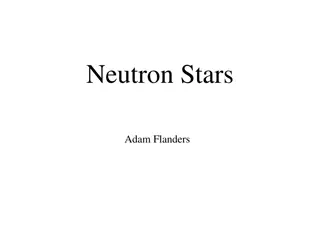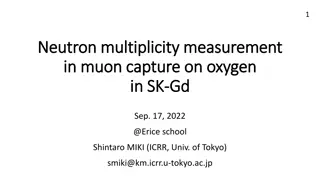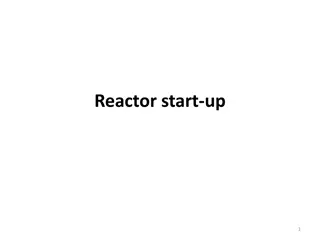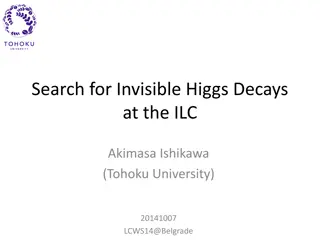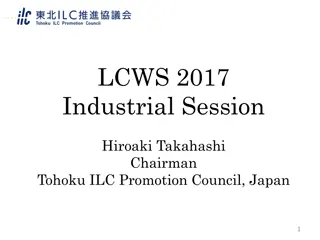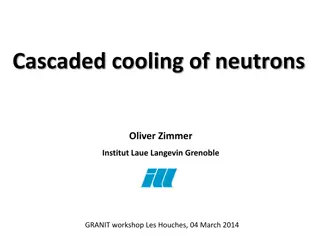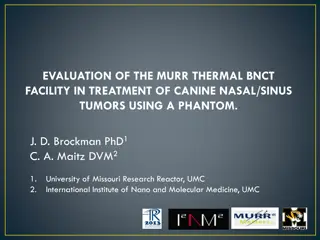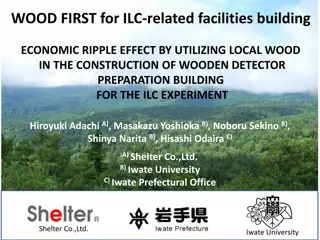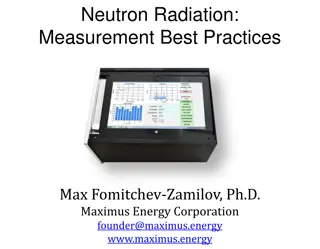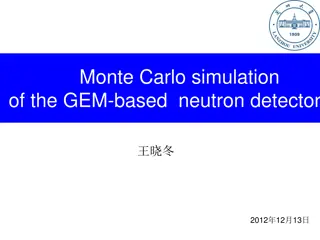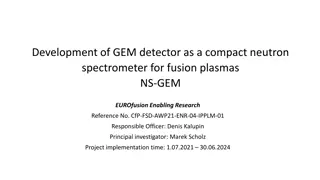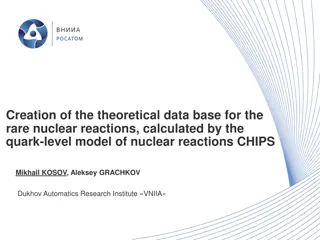Neutron Production Reactions at ILC - Applications and Estimations
Neutron production reactions at the International Linear Collider (ILC) involving nuclear reactions, photo-nuclear reactions with light and heavy nuclei, estimation of neutron production using gamma irradiation on Be-9, and application prospects. Cross-sections, energy inputs, and conversion rates are detailed for various reactions.
Download Presentation

Please find below an Image/Link to download the presentation.
The content on the website is provided AS IS for your information and personal use only. It may not be sold, licensed, or shared on other websites without obtaining consent from the author. Download presentation by click this link. If you encounter any issues during the download, it is possible that the publisher has removed the file from their server.
E N D
Presentation Transcript
ILC Neutron production with ILC Kenji MISHIMA KEK, J-PARC kenji.mishima@kek.jp 2018/Jul/6th, II
Contents 1. Neutron production reactions 2. Neutron production at ILC 3. Applications
Neutron production reactions Nuclear reaction 9Be + ? n + 12C 7Li + p n + 7Be 9Be + ? n + 8Be Fission 235U + n Fission Products + 2.4 n Fusion D + T n + 4He En= 14.1 MeV D + D n + 3He En= 2.5 MeV Spallation Hg + p(~GeV) Fission Products + ~20 n
Photo Nuclear Reactions Two candidates for photo nuclear reactions: Light and Heavy nuclei 9Be + ? n + 8Be (Sn= 1.665 MeV) D + ? n + p (Sn= 2.225 MeV) Pros: Low Sn, No structure(monochromatic neutron), small photo attenuation Cons: Small cross section Heavy Nuclei (208Pb Sn= 7.368 MeV etc.) Pros: Large Cross section Cons: Nuclear structure makes broader neutrons, Large photo attenuation (large energy deposit)
Photo Nuclear Reactions 9Be( ,n )4He Threshold = 1665.3 keV ( ,n) is 1.2 mbarn at 1690 keV (En=25 keV) Due to detailed balance, the cross section near the threshold is expected to be 9Be( ,n )4He cross section ?(?,?) 1/?? C.W.Arnold et al., PhysRevC.85.044605
Photo Nuclear Reactions 208Pb ( ,n)207Pb Threshold (208Pb) = 7368 keV 40 mbarn at 7.500 MeV (En=130 keV) at pigmy dipole resonance (PDR) ( ,n) is 600 mbarn at 13 MeV (En=5.6 MeV) at giant dipole resonance (GPR) 208Pb( ,n)207Pb PDR resonance GDR peak n p Atlas of Giant Dipole Resonances (1999) INDC(NDS)-394 Distr. GN+NM T. Kondo et al., PHYSICAL REVIEW C 86, 014316 (2012)
Estimation of neutron production 9Be with 1.690 MeV gamma Parameter Value 9Be Target Threshold 1.66531 MeV Gamma energy 1.690 MeV Neutron energy 25 keV Number density 0.124 atoms/barn/cm 9Be( ,n)8Be cross section 1.2 mbarn Photo attenuation length 33 cm Gamma to neutron conversion rate 0.61% Energy input per neutron 280 MeV Cf. 50 MeV / neutron for spallation reaction
Estimation of neutron production 208Pb with 13 MeV gamma Parameter Value 208Pb Target Threshold 7.368 MeV Gamma energy 13 MeV Neutron energy 5.6 MeV Number density 0.033 atoms/barn/cm 208Pb( ,n)207Pb cross section 600 mbarn Photo attenuation length 1.6 cm Gamma to neutron conversion rate 3.2% Energy input per neutron 410 MeV Cf. 50 MeV/neutron for spallation reaction.
Estimation of neutron production 208Pb with 7.5 MeV gamma Parameter Value 208Pb Target Threshold 7.368 MeV Gamma energy 7.5 MeV Neutron energy 132 keV Number density 0.033 atoms/barn/cm 208Pb( ,n)207Pb cross section 40 mbarn Photo attenuation length 1.9 cm Gamma to neutron conversion rate 0.25% Energy input per neutron 3000 MeV Cf. 50 MeV/neutron for spallation reaction.
Neutrons source using Neutron halo isomers in stable nuclei Neutron production by laser/X-ray by neutron halo isomer exited by ICS gamma was proposed by Habs et al. If we can find such a good nuclei, very intense eV- neutrons can be obtained. Habs, D., et al. "Neutron halo isomers in stable nuclei and their possible application for the production of low energy, pulsed, polarized neutron beams of high intensity and high brilliance." Applied Physics B 103.2 (2011): 485-499.
Summary of photo neutron reactions Photo neutron reactions Cross sections are 1 to 600 mbarn. Production rate is order of 1%. Energy per neutron production is ~300 MeV, which is 6 times larger than spallation reaction (50 MeV). From the point of view of engineering, the heat removal of the target is very important. Ex. J-PARC spallation neutron source 3GeVx333uA=1MW Total neutron production is ~1017/s
This slide is from K. Yokoya. Distribution of the Beam Dumps Most practical use of extracted beam is the ones at the location of the beam dumps (Otherwise, extraction system must be added, which occupies a longitudinal length. Must be planned early. Distribution of the Beam Dumps is shown below blue: electron, red: positron The numbers shown are the upper limit of the beam power to be dumped (20% margin included) Mostly for commissioning or emergency except E-5, E+5, E+7, E-8 Hence the power of the full beam power at the beam line nearby is more than the number here The full beam can be dumped only at E-5, E+5, E+7 (The upper limit of the dumps exceeds the full power because future upgrades are taken into account) E-8 will not be built in ILC250GeV Yellow arrows indicate the bunch compressors. The rms bunch length is 6mm in the upstream (from DR) and 0.3mm in the downstream. Bunch Compression Bunch Compressio n E+7 E-4 2018/5/28 ALCW2018 Yokoya 14
This slide is from K. Yokoya. Beam Dump Specification PB max = The maximum beam power at the nearby beamline for ILC250GeV W = Upper limit of beam dump power (20% margin included) Name Purpose of the dump E GeV PB max W kW 100 100 100 2500 2500 300 2500 3000 100 100 100 2500 2500 300 60 kW 60 60 60 400 E-1 E-2 E-3 E-4 E-5 E-6 E-7 E-8 E+1 E+2 E+3 E+4 E+5 E+6 E+7 Commissioning of electron injector Electron beam extracted from DR Just before electron bunch compression Tuneup of electron ML Electron main dump Just after electron bunch compression Emergency dump right after electron ML (protect undulator) Spent electron after producing positron (for 5+5Hz operation)150 Positron before injection to DR Positron beam extracted from DR Just before positron bunch compression Tuneup of positron ML Positron main dump Just after positron bunch compression Photons from undulator 5 5 5 125 125 15 125 17000 60 60 8000 5 5 5 60 60 60 125 125 15 400 17000 60 ~0.008 300 2018/5/28 ALCW2018 Yokoya 15
[E+7] Photons from the undulators to produce positron This is absent if the e-driven scheme is chosen for positron production No variety in the operation mode in case of ILC250GeV Electron energy 125GeV (more precisely, 128GeV at undulater section entrance and 125GeV at exit) Average energy of all photons 6.3 MeV Number of photons generated (about 400 photons from each electron) per bunch 8 x 1012 per second 5.2 x 1016 Average energy of photons reaching the target 9.7 MeV (Low energy part is eliminated at the masks/collimators) Photon power at the target ~ 50 kW The target is thin (0.2X0). Most photons go through the target and reach the photon dump 2018/5/28 ALCW2018 Yokoya 16
This slide is from K. Yokoya. Photon Energy Distribution on Target 208Pb 9Be/D x black: no mask red: with masks blue: with masks & collimator (r=2.2mm) 2018/7 17
Neutron production at E+7 undulator Parameter Value Photon luminosity Photon flux 5.2 x 1016 photon/s Photon intensity 50 kW Total Energy of photon 208Pb Target Gamma energy 7.5 MeV Neutron energy 130 keV Gamma to neutron conversion rate 0.25% 1 x 1014neutron/sec Total neutron production 1/1000 of J-PARC
Neutron production at E+7 undulator Parameter Value Photon luminosity Photon flux 5.2 x 1016 photon/s Photon intensity 50 kW Total Energy of photon 9Be Target Gamma energy 1.670-1.690 MeV Neutron energy 5-25 keV Gamma to neutron conversion rate 0.6% 3 x 1014neutron/sec Total neutron production 1/300 of J-PARC
This slide is from K. Yokoya. [E-4, E+4] Right after ML (main linacs) Energy 125 GeV emittance 5 m.rad x 35 nm.rad Energy spread 0.19% (e-), 0.15% (e+) Energy spread of e- is larger because of the radiation in undulator Bunch length 0.3mm As at E+-6, Must be fixed to 0.3mm during collision experiments, but the the bunch compressor itself is capable of compressing the bunch down to at least 0.15mm. (But the energy spread would be doubled.) Therefore, if 0.15mm is absolutely needed, it might be possible to borrow a machine time hours/days Full beam power 2.5MW, beam dump < 400kW In case of `stealing ~10% the reinforcement of beam dump is not needed Note: The beam parameters at [E-7] are similar to above but the maximum power for this dump is limited to 60kW (because [E-7] is an emergency dump to protect the undulators) . Therefore, the use of [E-7] is presumably less useful than at [E-4, E+4] 2018/5/28 ALCW2018 Yokoya 20
This slide is from S.Sasaki. Possibility of neutron source using photon beam from ILC ILC main linac parameters @ E-4 Normalized emittance : 5.0 x 10-6 Total emittance at 125 GeV: 2.0 x 10-11 Beam current: 0.58 m rad m rad mA (10% of main current) Undulator parameters Undulator period l : Undulator strength K : Undulator type: Active undulator length: Field on-axis: 6.5 0.61 helical 20 0.1 cm m T Partial Flux thr 25 urad aperture Peak Photon Energy = 1.66 MeV
Neutron production at E-4 undulator Parameter Value 1.5 x 1013 photon/25urad/0.1%B.W/s Photon luminosity Photon flux 1.5 x 1014 photon/s (5-25 keV) Photon intensity 40 W Total Energy of photon 9Be Target Gamma energy 1.670-1.690 MeV Neutron energy 5-25 keV Gamma to neutron conversion rate 0.6% 1x1012neutron/sec Total neutron production 10-6of J-PARC
Summary of neutron production at ILC E+7 and E-4 is candidates. 5x1016 photon/s (50 kW)at E+7 undulator in 100% B.W. 1014 photon/s at (40 W) at E-4 undulator in 1%B.W.-25 urad Because the neutron production rate is ~0.3-0.6%, neutron production rate is 1012-1014 neutron/s. Velocity of 30 keV neutron is 2.4x106 m/s. If we use bunch structure of 552 ns, TOF length should be less than 1.2 m.
J-PARC Neutron/Muon Lab. (MLF) Neutron target station 1-MW Hg spallation target for neutron source. Because of pulse structure, ILC neutron facility will be MUCH smaller.
Application of keV/MeV neutrons Neutron cross section measurement with high energy resolution by transmission. n_TOF@CERN, ANNRI@JPARC, Los Alamos. Resolution of n_TOF@cern C. Guerrero et al., Eur. Phys. J. A (2013) 49: 27 keV neutron detector Neutron source ~ 100 m 1m sample 1 m 100 m keV neutron source is possible to measure total cross section with resolution of 10-4, which is better than n_TOF@CERN.
Application of keV/MeV neutrons Neutron microscopic imaging Neutron imaging with keV/MeV neutrons. 1000 times larger image can be obtained at sample potions at 1 mm. keV/MeV neutron detector Sample Neutron source ~ 100 m 1m 1 mm 1 mm 1 m
Neutron moderation 1.5 2 barn@2MeV ( 106) 20 barn@20 keV Neutron Flux at 4m [n/cm2/sec/mA] 1 =6.6x105 n/cm2/sec 0.5 Ep=2.4MeV En=270keV 1 0 0 2 3 4 5 Incident Neutron Energy [MeV] 2~3
Summary Photo-neutron reaction rate was calculated. For 9Be(g,n) at 1.690 MeV Gamma to neutron conversion rate ~ 0.6% Energy input per neutron ~ 280 MeV/n Cf. ~ 50 MeV/n for spallation neutron (J-PARC) 5x1016?/sec produces 1014 n/sec of keV neutrons. 1,000 times less production than J-PARC Heat on the target (50 kW) is the problem. Application keV neutron with TOF Thermal neutron with compact moderation Direct eV neutron production




